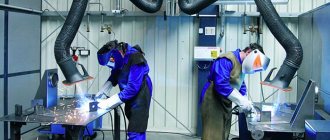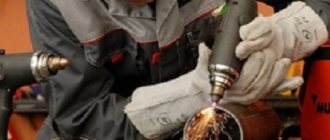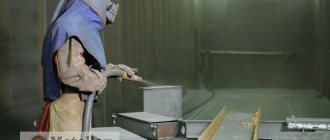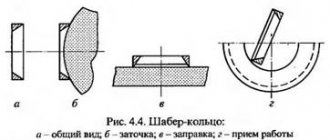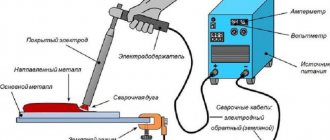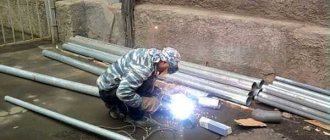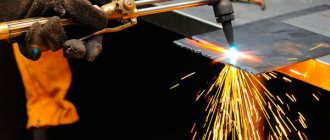Of all types of welding, electric arc welding ranks first in popularity. It does not require complex equipment or expensive materials. A distinctive feature of the technology is considered to be a by-product - welding slag, which is formed during the melting of metal. Depending on the quantity and location, it can be a useful or harmful waste.
What are slag inclusions
Welding slag is a glassy by-product material formed from the molten electrode coating or welding flux. The presence of slag inclusions is considered a very serious defect that can reduce the quality of the welded joint and the entire structure.
All slag inclusions arising on a metal surface during welding are divided into two types:
- macroscopic . Formed when the edges being welded are insufficiently cleaned or absent;
- microscopic . As a rule, they arise as a result of chemical reactions occurring during welding and crystallization of the metal.
Both types of inclusions have a negative impact on the mechanical characteristics of a metal product.
Basics of electric welding
Having understood the types and types of weld joints, you can move on to the basics of electric welding. If you plan to study on your own, then you will need to stock up on all the necessary materials. Since you will most likely experience a slight failure the first time you practice, it is better to stock up on a large amount of material.
It is also important to know some terms and symbols before starting work:
- A welding arc is a gas heated to incredibly high temperatures (about 5-7 thousand), so you need to handle welding with extreme care, otherwise you risk causing serious burns to yourself or others.
- Arc Welding – This type of welding is done using an electric arc that heats gas to incredibly high temperatures. Upon contact with the surface of a metal product, the metal begins to melt, resulting in the formation of a so-called “weld pool”. After the metal cools, a weld appears.
- Argon arc welding is practically the same as an arc type of welding, only argon must be used as the heated gas. This type of welding is very suitable for various reinforcement rods with a thickness of no more than 5 millimeters.
Reasons why slag inclusions form
Quite often, only specialists mastering welding technologies wonder why a lot of slag is formed at the connecting joints during welding. The appearance of such inclusions is due to various factors:
- the metal cools faster than usual and the slag simply does not have time to leave the weld pool;
- low quality electrodes used in welding. In this case, melting occurs unevenly and electrode particles enter the weld pool;
- at low values of metal deoxidation, a lot of slag is formed during welding. This is a process in which oxygen molecules are eliminated from an already soft metal. They worsen the mechanical properties of the metal and destroy its structure;
- poor-quality preparation and cleaning of welded edges from dirt, rust and oils;
- high values of surface tension of the slag prevent it from floating to the surface;
- the use of flux or electrodes made of refractory metals and with a high specific gravity;
- non-compliance with welding modes and technology, for example, incorrectly selected angle of inclination or inappropriate speed of electrode movement.
In order to weld without slag or with a minimum amount of it, it is advisable to seek help from experienced welders. If you want to weld yourself, then you should learn how to weld the simplest elements and only then proceed to more complex ones.
How to distinguish slag from metal
Welders, especially beginners, face various problems and questions when creating metal products by welding. For example, many find it difficult to distinguish slag from metal when welding.
In reality, it is not difficult to distinguish between metal and slag inclusions. To do this, you should pay attention to the following factors:
- color . Under the influence of high temperature, the metal melts during welding, acquiring a reddish tint. As the metal cools, the color of the reddened metal darkens. Slag behaves completely differently. It has a dark color directly during the welding process, and when it cools it becomes lighter;
- cooling rate . Metal, unlike slag, hardens much faster;
- the structure of the cooled metal alloy is more dense, and the slag inclusions form a loose crust;
- fluidity _ When melted, the metal is more liquid, which contributes to its greater mobility. During the welding process, it is easy to see how it boils. The slag is more viscous and does not heat up as well.
You can distinguish slag from metal during welding directly at the moment when it appears in the weld pool. If you watch how the metal melts, you can see the appearance of a bright light under the tip of the electrode, and behind its outlines you can see the clear contours of the butt joint and the weld pool itself. Metal is identified by its light shade, slag by its dark shade.
Reasons for the appearance of large amounts of welding slag
When welding, a black loose crust is formed over the place where the metal is joined (seam) - welding slag. It consists of molten flux or electrode coating, oxidized metal. In the process of melting and joining the materials to be welded and the electrode, it closes the melting bath. Thanks to the slag, the seam cools slowly, without oxygen, and does not oxidize.
Once molten waste gets directly into the seam, it causes rapid destruction of the metal. You can prevent oxides from getting into the seam by changing the welding modes and position of the part.
Welding slag
To prevent leakage and clogging of the seam, you need to know how slag differs from metal when welding. As a rule, these are materials of different density and viscosity that heat up at different rates. At the beginning of welding, the metal begins to melt and turns red.
After welding is completed, it cools down faster and darkens. The slag is blown out of the bath onto the surface. At the beginning of work it is dark and poorly heated. It cools down more slowly and becomes lighter than the metal.
By cleaning the seam and tapping it with a hammer, it is easy to recognize the metallic sheen of clean steel and black matte inclusions.
There is no pure iron in slag; it consists of oxides that are formed during the melting of metal and flux. The composition varies slightly depending on the coating of the rod, but basically consists of the same substances. The table shows data on the 3 types of electrodes used most frequently:
| New welders face many problems and questions that arise during the process. So, at the first stages, many find it difficult to distinguish slag from metal, and how to expel this slag during welding. In this article we will talk about how to do this and what is needed to ensure a high-quality weld. The main difference between melting metal and slag during welding is its fluidity. The metal is more liquid and mobile, and during the welding process itself you can clearly see how it boils in the weld pool. In turn, slag is more viscous and has a darker shade. Situations often arise when slag floats onto the weld pool. In such a situation, the welder can hardly see anything, and to avoid this, he has to tilt the electrode in such a way that the gas stream (which evaporates from the coating) blows the slag back onto the weld. After this, the weld pool opens again and the welding site becomes clearly visible.
Thus, a novice welder always needs to keep one rule in mind - under no circumstances should slag run into the weld pool, and then the quality of welds will be much better. | |||
| Substance, oxide | , % SSSI | , % OMM-5 | , % C-3 |
| gland | 7,9 | 13,2 | 18,5 |
| titanium | 2,2 | 15,2 | 12,2 |
| manganese | 4,6 | 28,9 | 13,7 |
| calcium | 42 | 3,6 | 8,1 |
| silica | 43,3 | 39,1 | 47,5 |
The composition depends on the material of the rod itself and the coating. Iron oxide is partially obtained as a result of contact of the material with air at high temperatures.
Welding slag as a prerequisite for the occurrence of welding inclusions
At the initial stage, the oxides protect the hot metal from rapid cooling and close the seam from above, blocking the access of air. Then they must be removed to check the quality of the connection, the presence of defects in the form of non-metallic inclusions, tops.
When welding parts of large thickness, several seams are applied in succession. Uncleaned slag will prevent normal contact and extinguish the arc. It will remain in the form of non-metallic inclusions - defects.
Reasons why a defect must be removed after work
Slag inclusions have a porous structure and consist of oxides. They reduce the strength of the metal. Immediately after cooling, when it turns black, the welding slag should be removed. It is porous, fragile without strong bonds.
Flux and slag vapors above the bath prevent oxidation of the metal during welding and help create a homogeneous structure. After it moves away from the part during the cooling process, it becomes unnecessary and interferes with further processing of the part. During operation of the product, oxides from the slag can enter into a chemical reaction with iron. The pieces falling off will break the mechanism.
Slag removal
The main reasons for the appearance of slag inclusions
When the weld seam is rapidly cooled, the slag does not have time to come out and solidifies in the metal. The reasons are:
- low voltage;
- slag flowing from the bath in front of the electrode;
- incorrectly selected diameter;
- rusty and dirty metal;
- uneven movement of the tool.
The operating voltage is indicated on the package with electrodes. It can be exceeded a little, then the boiling metal in the bathroom will throw out slag. It is necessary to select the correct position of the metal to be welded, lift it from the end of the seam. Do not hold the electrode strictly perpendicular, but tilt it 10–15⁰ towards you.
The metal at the welding site should be shiny. It must be cleaned of household and industrial waste, scale, and oil. They interfere with the contact of the electric arc with the steel, impairing the heating and melting of the material in the bath.
To slow down the cooling of the weld and allow the slag to escape freely, large parts and alloyed metals are preheated to 200–400⁰. This relieves stress and allows steel with high carbon and alloy content to be welded.
Why does a lot of slag form when you cook with electrodes?
During the welding process, the electrode coating or flux dissolves. Some of the iron, sulfur and phosphorus from the material being welded burns out. The electrical conductivity of slag is less than that of metal, so it heats up worse and extinguishes the arc. Increased voltage and incorrectly selected operating parameters, electrodes contribute to metal burnout, oxidation of iron and other steel elements.
The reason why there is a lot of slag lies in its structure. All substances formed as a result of metal melting from an electric arc are lighter than steel, do not have strong bonds with each other and float to the surface.
Welding process
Welding with an inverter for beginners, how to weld without slag inclusions
The inverter turns alternating current into direct current and allows you to change the polarity. Reverse current welding usually produces less slag.
The advantages of an inverter over a conventional welding machine are its small size and operation on current with a household voltage of 220 W and a frequency of 50 Hz. For beginners, it is important to be able to smoothly change the current strength.
Inverter devices have additional arc functions:
- easier ignition;
- emergency shutdown when stuck;
- afterburner ignition.
All of them simplify the work of an inexperienced welder and prevent sticking of the electrode.
How to get rid
You can get rid of slag when welding with an inverter by changing the polarity of the current and moving the electrode from minus to plus. When working with thin metal, it is necessary to take into account its rapid cooling and do not apply high voltage; the sheet may burn out.
You can’t stay in one place for a long time; you need to move the arc evenly and quickly. A terminal from “–” is attached to a thin sheet, and “+” is applied to the electrode.
The thick sheet heats up and cools down longer so that the slag has time to come out, minus is applied to the metal being welded, and plus is applied to the electrode.
Why does slag need to be removed?
Slag inclusions mainly consist of oxides due to their porous structure and significantly reduce the strength properties of the metal. During operation of a welded structure, oxides from the slag are capable of entering into a chemical reaction with iron, which leads to its destruction. Therefore, immediately after cooling, when the slag turns black, it must be removed.
At the initial stage of welding, the slag with oxides formed above the pool protects the metal from rapid cooling. Since the temperature of the metal decreases much more slowly, when removing slag after welding, the seams are more even and uniform.
There are other reasons why it is recommended to remove the slag formed at the joints after welding parts:
- it is much easier to check the quality of the welded joint when there are no slag inclusions on it;
- paint and varnish coatings are often applied to finished products, and the presence of slag inclusions significantly worsens the appearance of structures;
- If it is necessary to perform a shock in several layers, you must first remove the slag and only then create the next layer.
Note! If the welding slag is not removed, it may be impossible to use the finished product due to defects present in the form of tops and non-metallic inclusions. This is especially important for structures that will be subject to high external loads during operation.
Why does the weld seam slag?
What causes defects to appear? What should a welder be able to do to avoid them? What should be done if defects occur? The main causes of defects in welding seams can be divided into three groups:
1. Quality and storage of basic and auxiliary materials;
2. Preparation for welding of main and auxiliary materials;
3. Welder qualification.
Poor arc ignition
Poor ignition - sticking of the electrode, excessive increase in arc length - leads to lack of penetration at the beginning of welding, slagging, and pore formation. Poor quality production of electrodes, namely excessive exposure of the end of the electrodes at the ignition site, results in a bunch of pores, the so-called “starting pores”.
It is necessary to stop, perform mechanical cleaning, removal, or cut out the defective beginning with a chisel, and only then resume the ignition.
Excessively “convex” rollers
Excessively “convex” beads when welding corner and butt joints lead to welding of subsequent beads to the slag, lack of penetration between the groove edge and the convex seam, or between deep recesses between the beads (Fig. 80).
Such rollers are usually obtained in the following cases:
- low welding speed without manipulation - increase the forward movement of the electrode;
- manipulating the “arc backward” when welding vertical and ceiling seams - switch to the “ladder” or “arc forward” method;
- angle of inclination of the electrode (welding “backward angle”) for ceiling seams - switch to welding “forward angle” or at a right angle to the welding direction;
- low welding current for the lower position - increase the current;
- Excessive welding current for vertical and ceiling seams - reduce to a minimum.
During welding, it is necessary to monitor the completeness and geometry of the seam, the liquid pool and control it by manipulating the speed and inclination of the electrode. Edge delay is very important. The more we heat the edge, the better the liquid weld metal forms on it when the electrode moves to the other edge, and does not collect in the middle of the seam.
Undercuts
Undercuts lead to slagging and lack of penetration. In Fig. 81a shows undercuts: 1 - in the body of the weld section, very dangerous, especially when welding stainless steels.
An undercut is formed; 1) when the electrode leaves the edge early (the crater is not filled with electrode metal); 2) with a very short arc (“support welding”), when the “visor” of the coating trims the crystallizing weld metal; 3) when abruptly moving away from the edge. Liquid slag fills the undercut.
While we are melting the other edge, the slag solidifies in the undercut and when returning it it is not always possible to melt it. This leads to a defect.
To avoid this, a delay at the edge is necessary until the crater is completely filled with electrode metal. The transition to the other edge should be carried out smoothly, without sudden fluctuations.
Surges
Rice. 81b. If there is an excessive delay at the edge, a leak of liquid metal occurs, as well as with a high welding current, when the welder cannot cope with the liquid metal of the seam. Cut down the flood and clean it up.
Lack of penetration
In drawings, technical processes or welding reference books, the gap during assembly can be set from 0 to 2-3 mm.
Assembly without a gap or with a gap less than recommended when welding a V-shaped groove (without welding the weld root on the reverse side) will lead to defects - lack of penetration and slagging of the weld root (Fig.
82); and for 2-sided welding, X-shaped and V-shaped (with back welding on the reverse side), it will require additional costs and time for deeper sampling of the reverse side of the root of the weld, partial bevel of the edges and unnecessary consumption of electrodes to fill the deep sampling.
Fistulas
Fistulas in the weld crater at the end of welding occur when the welding current is excessive, and also when the arc is separated by lengthening the arc.
Shrinkage shell
Shrinkage cavity most often appears when welding a root bead, large metal thicknesses, large gaps and especially when welding austenitic steels, as well as excessively high current and an excessive size of the weld pool.
When shrinkage occurs, a crack sometimes appears in the crater of the roller. This sharply reduces labor productivity due to the need for mechanical cleaning after finishing each electrode.
When welding pearlitic steels with rigid fastening of parts, a shell with a crack is most often formed, and when welding austenitic steels, the reason for the appearance of shells with cracks is low heat transfer and high linear expansion.
It is necessary to bring the crater back to the seam or to the cutting edge.
It is recommended to carry out welding:
- in a reverse stepwise manner;
- continuously (by two welders) with arc interception;
- using the "arc-to-arc" method.
Pores
Pores in a weld are formed for many reasons:
- poor-quality edge preparation (dirt, scale, rust) - clean;
- high moisture content leads to the formation of pores, it is necessary to preheat the welded edges and calcinate the electrodes;
- drafts in the welding zone;
- poor-quality electrodes: rusty metal rod, eccentric coating leads to a “peak” and an increase in arc length;
- strong magnetic blast, which causes a large deflection of the arc, which increases its length;
- mismatch between the base metal and filler material in terms of chemical composition. And other reasons that require preparation in a specific case.
Reasons that cause pores, depending on the qualifications of the welder:
- unclear ignition of the arc (sticking, rise of the electrode after ignition to a very high arc length) and an attempt to remelt such ignition leads to defects;
- long arc welding.
A detailed study of practical tips, practicing during training, and applying them in practice will help welders improve the quality of welding operations performed during the manufacture and installation of critical products for nuclear power plants, thermal power plants, chemical and other equipment at enterprises where high demands are placed on treacherous joints.
Tudvasev V.A. “Recommendations for welders”, 1996
How to distinguish slag from metal when welding
» Articles » How to distinguish slag from metal when welding
Why does the weld seam slag?
Slag inclusion is a weld defect in the form of slag residues in the weld metal remaining after crystallization of the metal. There are slag inclusions: linear (3011); disconnected (3012); others (3013).
An acceptable defect in the manufacture of non-critical structures.
Inadmissible defect. When welding structures operating under low-cycle loading and critical structures.
Inclusions are internal defects and are therefore detected by non-destructive testing methods.
How to minimize slag inclusions when welding metals
Many novice craftsmen are concerned about the question “why is there a lot of slag when welding with an inverter?” Typically, such problems are observed during welding when the elements are in the lower position. In cases where the part is located on a slope, the slag drains much faster than the liquid metal mixture from the weld pool. Due to the fact that the slag did not have time to come out, it remains in the weld seam.
Also, slag formations appear when gaps are excessively large or when the current is insufficient in relation to the thickness of the metal. Much less often, problems with slag arise when creating vertical seams, while the seam remains on top and the slag flows down.
Some professional welders advise placing the workpiece on an incline and welding from top to bottom, while others suggest using slag-free electrodes with a dark coating for welding.
To prevent slag particles from getting inside the weld pool, the direction of the electrode should be coordinated. It must be positioned in such a way that when the electrode coating evaporates, the gas flow “blows” such a defect onto the outer surface of the connecting joint. You cannot leave slag in the weld pool. It should crystallize quickly, allowing you to remove it without much effort.
Typical welding errors and defects
When depositing the first bead along the root of a butt weld, metal penetration into the root may be insufficient due to insufficient welding current or excessive welding speed. The reason may also be that the electrode diameter is too large for the groove. If the welding current is too strong, the root of the weld may burn through.
Fusion defects
If the current is insufficient or the welding speed is too high, lack of fusion between the weld metal and the base metal may occur.
Failure of fusion can also occur if too small an electrode is used when welding over a large area of cold base metal. In this case, you should use a larger diameter electrode and heat the base metal.
Seam edge defects
Edge defects can occur due to excessive welding current. However, such defects can also occur with the correct current, if the arc is too long or if the electrode is not moved correctly.
When welding from bottom to top in a vertical position with an oscillating movement of the electrode, the latter must be pressed momentarily against each side of the roller so that the metal penetrates well into the seam and to avoid defects in the seam edge.
Edge defects can be indicators of a break in the weld.
Pores in the weld
Porosity in the weld can form due to moisture content in the electrode coating, especially when welding with base coated electrodes. In addition, the cause of pore formation may be wet or damp base metal of the workpiece being welded. Such a seam impairs the strength of the connection.
Thermal cracks
Thermal cracks can form during and immediately after the weld cooling period for two main reasons:
Due to inclusions in the base metal which tend to segregate and may form a layer in the middle of the weld. This layer prevents the crystals from merging. These substances primarily include carbon and sulfur.
In cases where thermal cracks are caused by such substances, switch to a basic coated electrode. If cracks appear during welding with an electrode with a base coating, then this metal is unweldable.
Stress through the weld can cause thermal cracks to appear, even if the base metal does not segregate in the weld. At a certain critical temperature interval, immediately after coagulation of the bead, the seam has very little ability to deform and, if the shrinkage of the metal is greater than the tensile strength of the seam, a crack will form. This can be avoided by clamping the part to be welded with a special clamping device, which limits the shrinkage of the metal.
Thermal cracks appear in the middle of the bead and are a straight crack on the surface.
Shrinkage cracks
Shrinkage cracks form when the ability of a weld to deform (toughness) is less than the actual shrinkage. Such cracks are usually transverse and are caused by significant longitudinal shrinkage. To avoid the formation of such cracks, it is best to use electrodes with a basic coating.
Hydrogen cracks
Cracks in weld metal are caused by hydrogen and can occur in any type of steel that has been hardened or is being hardened during welding.
High yield strength steel will contain a certain amount of strengthened structure, usually martensite.
The higher the melting point, the higher the risk of hydrogen cracks; they form in the base metal, which is directly adjacent to the melting zone, and, combined with welding voltage, form cracks in the weld metal.
For welding hardened steel, only dry electrodes with a basic coating can be used, since in this case very little hydrogen is released. Wet electrodes release a lot of hydrogen. Other sources of hydrogen include rust, oil, paint, or condensation along the weld groove. Heating the groove to, say, 50°C will significantly reduce the amount of hydrogen.
Slag inclusions in the weld
Slag consists of non-metallic particles from the electrode coating. After each roller, all slag must be carefully removed. To do this, use a chipping hammer and a wire brush. Slag particles trapped in the seam will seriously reduce the strength of the joint. Try to avoid burning out the recesses, as slag trapped there is difficult to remove.
When preparing the weld groove, ensure that it has sufficient clearance to ensure good fusion and facilitate slag removal. Remove scale and rust from the surface being welded and check whether you have selected the correct electrode for this welding position.
How to get rid of slag
To get rid of slag when welding, you can try to increase the arc. This will prevent slag formations from flowing under the weld pool.
By changing the polarity of the current when welding with an inverter and moving the electrode from minus to plus, you can prevent the accumulation of slag in the weld. You can’t stay in one place for too long; you need to move the arc quickly and evenly.
If the dimensions of the product allow, you can try to “drive” the slag back by changing the angle of inclination of the part. Inverter welding with reverse currents produces less slag. Such a device is best used by novice welders, as they prevent sticking of the electrode and greatly simplify the welding process.

